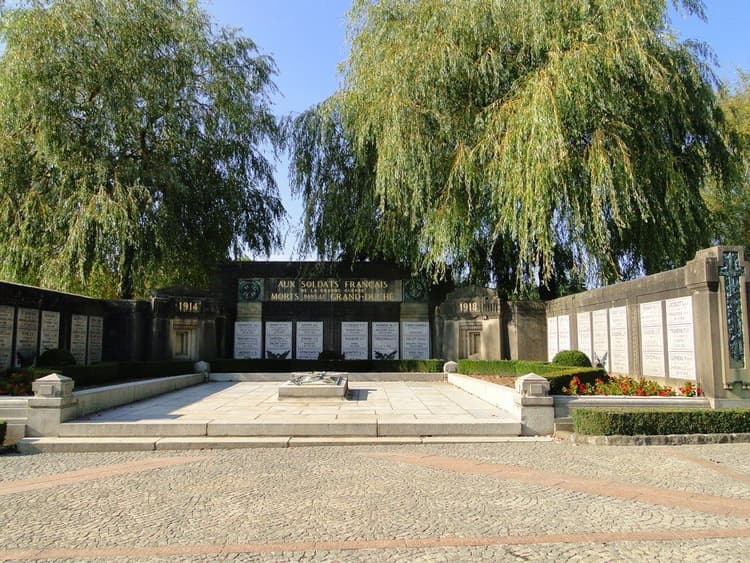
Cemeteries of Luxembourg
Welcome to the silent realm of Luxembourg's cemeteries, where history whispers between the tombs and shadows dance in the moonlight. Here, every tombstone tells a story, often more vividly than the living themselves! Between majestic mausoleums and mysterious sculptures, let yourself be enchanted by the Gothic charm and the mischievous wink of these sanctuaries of memory.
In addition to serving as a final resting place for the deceased, cemeteries provide a space for remembrance and mourning, preserve a community's history and cultural memory, and offer a peaceful setting for reflection and connection with the past. They may also be of historical and architectural interest.
An overview cemeteries in Luxembourg
Before discovering the country's most emblematic cemeteries, let's take a look at historical burial practices and current cemetery legislation in Luxembourg. Understanding these aspects is essential to fully appreciate the cultural and heritage significance of Luxembourg's cemeteries, true keepers of collective memory.
History of burial practices in Luxembourg
Early burial practices in Luxembourg were characterized by simple rites, often influenced by nature and animistic beliefs. With the arrival of Christianity, traditional funeral customs evolved, incorporating important religious influences. The Day of the Dead, celebrated every year on November 2, is a high point, when Luxembourgers honor their deceased with prayers and visits to cemeteries, where graves are lit with candl
Historically, the transition to a more structured cemetery system was influenced by sanitary and religious reforms that led to the establishment of separate municipal and parish cemeteries. Today, there are several types of cemeteries in Luxembourg, ranging from municipal cemeteries to military cemeteries and special memorials.
Cemeteries in Luxembourg are not only places of burial, but also spaces of reflection and remembrance for the community. Modern burial practices, which respect tradition while integrating contemporary elements, reflect the evolution of Luxembourg society and its deep respect for its ancestors.
Read article
Legislation and policy
Funeral legislation in Luxembourg has been marked by two major events. First, the adoption of the law of July 24, 2004, which reformed the funeral legislation to regulate funeral services and cemeteries. This law guarantees the quality of services and the respect of funeral traditions, thus ensuring the professional and dignified management of cemeteries in Luxembourg.
Secondly, the law of July 17, 2009 reformed the legislation on classified establishments, including specific provisions for funeral services and crematoria. This law aims to modernize and regulate funeral practices, taking into account social and environmental developments.
Municipal and governmental bodies play a crucial role in the application of these laws, ensuring the management and maintenance of cemeteries, as well as compliance with regulations.
Green burial initiatives are also underway to reduce the environmental impact of burial practices. These initiatives include the use of biodegradable caskets and the promotion of natural cemeteries to help preserve the environment.
Types of cemeteries in Luxembourg
Luxembourg's cemeteries reflect the cultural and historical diversity of the country. Here's an overview of the different types of cemeteries:




Each type of cemetery in Luxembourg plays a unique role in commemorating the deceased and preserving local history and traditions. In the following sections, we will take a closer look at some of the country's most important cemeteries and explore cemeteries of different types.
Civic and religious cemeteries in Luxembourg
Luxembourg's civil and religious cemeteries are places where history, culture and tradition come together. They bear witness to spiritual diversity and community unity through their carefully tended graves and peaceful landscapes. Each cemetery, whether secular or religious, offers a sacred space for remembrance and contemplation.
Bonnevoie
Bonnevoie Cemetery is located in one of the most diverse, populous and multicultural neighborhoods of Luxembourg City. Located behind the main train station, Bonnevoie was once a neighborhood inhabited mainly by working class Luxembourgers, Italians and later Portuguese.
The oldest graves in the Bonnevoie cemetery date from the late 19th and early 20th centuries. The tombstones are generally large and tall, made of stone or marble, and decorated with crosses, statues of Christ and various representations of the Virgin Mary. Bonnevoie contains many graves of emigrants from southern Europe and their descendants, with a variety of shapes and colorful building materials.
The site is home to a wide variety of emigrants from Eastern Europe, Asia and Africa, practicing different religions such as Christianity, Islam and other faiths.
Established: 1882
Cessange forest cemetery
Each tree in this cemetery has ten plots, which act as a concession. People must be cremated and can choose to have their ashes scattered at the foot of the tree or in the cemetery. The deposit of ashes may or may not be accompanied by a religious ceremony. If the deceased chooses to be laid to rest at the foot of the tree, a commemorative plaque will be installed, bearing his or her surname, first name, date of birth and date of death.
Established: 2014
Old Jewish cemetery in Clausen
Shortly thereafter, in 1817, the first Jewish cemetery in Luxembourg was established. It received the first members of the Ettelbruck Jewish community and remained in use until 1884, when the Bellevue cemetery took over.
Established: 1817
Ettelbruck cemetery
The synagogue, the Jewish cemetery, the school, and a few old store names are all that remains at first glance of the once thriving Jewish life in Ettelbruck. The first Jewish family arrived in Ettelbruck in 1810. Later, on March 17, 1865, Joseph Cahen, on behalf of the Jewish community living in Ettelbruck, purchased an 8-acre garden for the purpose of building a synagogue, located on today's Rue de Warken. The synagogue was inaugurated in 1870.
It wasn't until 1880 that the city council authorized the construction of a Jewish cemetery on Ditgesbaach. On June 11, 1882, eight-year-old Auguste Levy, son of Feis Levy and Rosine Kahn, was the first to be buried in the new cemetery. This cemetery is still in use today. The last burial took place in 2007.
Established: 1881
Differdange Cemetery

Historical cemeteries in Luxembourg
Luxembourg, with its rich military past, played a decisive role in the Second World War, becoming the scene of intense fighting. Today, several historic cemeteries commemorate this legacy. The Luxembourg American Cemetery and Memorial in Hamm honors the American soldiers who fell during the liberation of the country. The Cimetière de Notre-Dame in Luxembourg City contains the graves of illustrious figures from Luxembourg's history. The German War Cemetery in Sandweiler honors the German soldiers who fell during the World Wars.
Each of these sites is not only a shrine to the dead, but also a poignant testimony to military history and the sacrifices made for freedom and peace. Below, we take a closer look at these and other historic cemeteries across the country.
Luxembourg American Cemetery
Founded on December 29, 1944 by the 609th Quartermaster Company of the U.S. Third Army, the cemetery bears witness to the efforts of the Allied forces to counter the enemy's desperate offensive during the Battle of the Ardennes, one of the most important battles of the Second World War. The cemetery contains the graves of 5,070 soldiers, many of whom died during the Battle of the Bulge and the advance to the Rhine. Among the important figures buried here is General George S. Patton, the emblematic symbol of the American war effort in Europe.
Established: 1944
Read article
Sandweiler German military cemetery
The origin of this cemetery is closely linked to the creation of the Luxembourg American Cemetery mentioned above. After the fighting, the American burial service exhumed and regrouped the fallen soldiers. The Americans were regrouped in Hamm, where the Luxembourg American Cemetery was created, while the Germans were buried in Sandweiler, less than two kilometers away. When the American work was completed, the German cemetery already contained 5,599 graves.
In 1952, the government of the Federal Republic of Germany and the government of Luxembourg signed an agreement on military graves. At Sandweiler, the graves of German soldiers scattered over 150 sites in Luxembourg were brought together, adding another 5,286 bodies to the ossuaries. The cemetery was inaugurated in 1955.
Established: 1955
Notre-Dame Cemetery
This cemetery dates back to the 18th century. In 1755, a cemetery known as Nikloskierfecht was established near the church of St. Nicholas. However, the church was demolished in 1779. After its demolition, the parish seat of Saint-Nicolas was moved to the former Jesuit church, now the cathedral Notre-Dame de Luxembourg, and the parish cemetery was moved outside the city walls, to the Glacis. The new cemetery was located near the chapel of Notre-Dame, which explains its official name.
The cemetery has two major monuments: the Monument de la Résistance et de la Déportation and the Mausoleum of the French soldiers killed in Luxembourg during the First World War.
An interesting feature of this cemetery is the presence of many remarkable graves. Over the past three years, approximately 54 graves have been marked with QR codes, allowing visitors to access information about the buried individuals by scanning the codes with their mobile phones.
Established: 1779 - 1780
Frequently Asked Questions (FAQ)
What are the most important historical cemeteries in Luxembourg?
How are ecological initiatives influencing burial practices in Luxembourg?
What's special about Notre-Dame Cemetery in Luxembourg City?
Source: www.eternum.lu, www.vdl.lu, www.vdl.lu, www.fnr.lu, cemi-hera.org, lequotidien.lu, www.virgule.lu, jguideeurope.org, www.facebook.com, www.mywort.lu, www.tageblatt.lu, www.abmc.gov, fr.wikipedia.org, kriegsgraeberstaetten.volksbund.de, fr.wikipedia.org, lequotidien.lu, fr.wikipedia.org
We took photos from these sources: Wikipedia, fnr.lu, Geneanet, Google Maps, U.S. Embassy in Luxembourg, Diego Marín on Unsplash




















